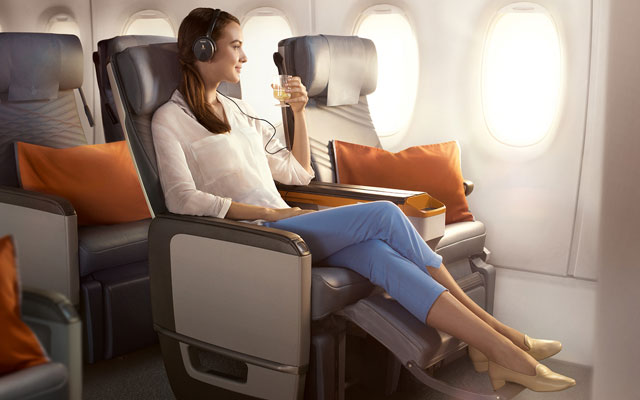Global travel management company Carlson Wagonlit Travel, and travel commerce platform Travelport, have found that premium economy is the fastest growing cabin segment for business travellers in Singapore.
An analysis of over 1.3 million bookings made between January 1, 2015 and December 31, 2017, with Singapore as the point of origin, showed that the number of premium economy seats booked for corporate travel increased at an average rate of 157% year-on-year. In comparison, corporate bookings for other classes recorded negative growth over this three-year period.

“One can easily see the appeal that premium economy has for corporate travel programmes,” said Richard Johnson, director, Asia Pacific, CWT Solutions Group. “It gives travellers that much-needed extra comfort versus economy class on medium- to longhaul flights, while costing their companies significantly less than a business class ticket.”
The seat share of premium economy as a proportion of total bookings has increased steadily too. In 2015, premium economy comprised only 1.2% of total corporate travel bookings, and this grew to 7% by the end of 2017.
Meanwhile, the economy class seat share declined to 54.5% in 2017, compared to 60.3% in 2015. Business class bookings have remained relatively flat, comprising 37.7% of corporate travel bookings in 2017 versus 37.6% in 2015.
 “It’s interesting that the increase in premium economy bookings seems to have come largely at the expense of economy class, and not business class,” said Johnson. “This makes sense, given the trend we’re seeing where companies are looking beyond travel costs and paying more attention to traveller comfort and productivity.”
“It’s interesting that the increase in premium economy bookings seems to have come largely at the expense of economy class, and not business class,” said Johnson. “This makes sense, given the trend we’re seeing where companies are looking beyond travel costs and paying more attention to traveller comfort and productivity.”
Flying economy class on medium- to longhaul flights was identified as the third- strongest stress-inducing factor for business travellers, according to an earlier study done by Carlson Wagonlit Travel called the Travel Stress Index. Such stress results in lost time and reduces the overall productivity of the traveller.
“When you look at corporate travel policies, we have seen more companies allowing their employees to travel premium economy over the last few years,” added Johnson. “Still, only around a quarter of our clients have policies that explicitly allow their travellers to book this cabin class, suggesting that there’s still a lot of room for growth for premium economy in corporate travel.”

Looking at supply, it’s clear that airlines are increasingly seeing a viable business case for premium economy. At the end of 2017, one in five airlines flying into Singapore offered premium economy, with the service available on more than 30% of routes from Singapore. For example, four in 10 planes from Singapore’s national carrier, Singapore Airlines, offer premium economy as an option, with plans to increase this further.
Supply seat share of premium economy versus other cabin classes has also increased at a steady pace. The number of premium economy seats available as a proportion of total airline seats increased from 2.5% in 2015 to 3.6% in 2017. The data suggests that airlines have made room for premium economy by reducing the number of first and economy class seats.
“With this trend we see, it has become even more imperative for corporates to work with technology partners and travel management companies who are able to provide accurate and comprehensive content choices for their travellers,” commented Mark Meehan, managing director Asia Pacific for Travelport.
“Technology such as branded fares and ancillaries, which can provide access to rich images of airline seat options and other airline products, will give corporates better value and coverage of available airline content.”





















